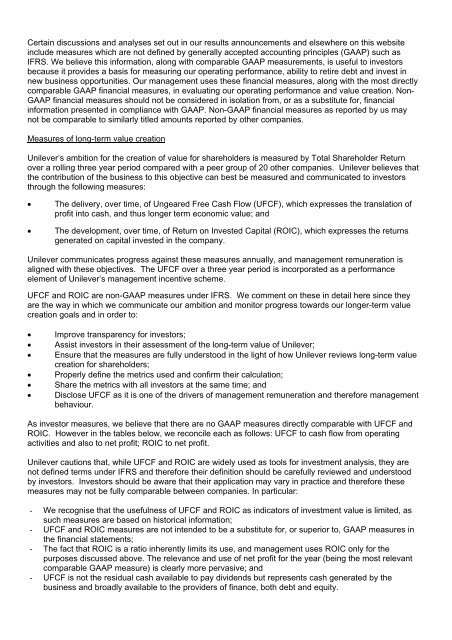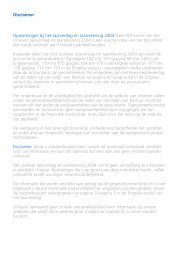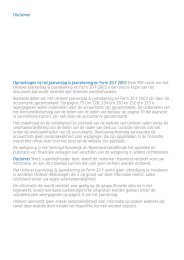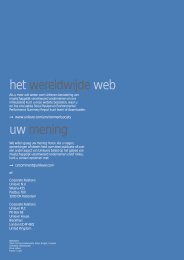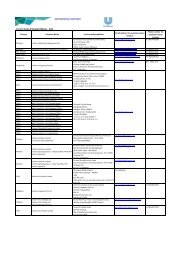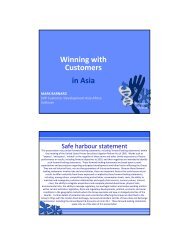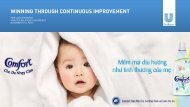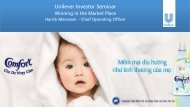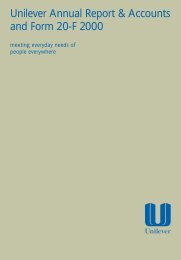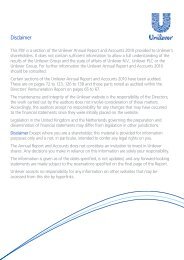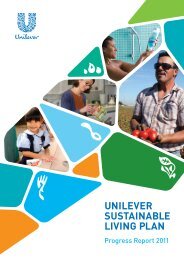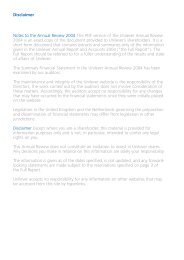Q4 2007 Non GAAP measures - Unilever
Q4 2007 Non GAAP measures - Unilever
Q4 2007 Non GAAP measures - Unilever
Create successful ePaper yourself
Turn your PDF publications into a flip-book with our unique Google optimized e-Paper software.
Certain discussions and analyses set out in our results announcements and elsewhere on this website<br />
include <strong>measures</strong> which are not defined by generally accepted accounting principles (<strong>GAAP</strong>) such as<br />
IFRS. We believe this information, along with comparable <strong>GAAP</strong> measurements, is useful to investors<br />
because it provides a basis for measuring our operating performance, ability to retire debt and invest in<br />
new business opportunities. Our management uses these financial <strong>measures</strong>, along with the most directly<br />
comparable <strong>GAAP</strong> financial <strong>measures</strong>, in evaluating our operating performance and value creation. <strong>Non</strong>-<br />
<strong>GAAP</strong> financial <strong>measures</strong> should not be considered in isolation from, or as a substitute for, financial<br />
information presented in compliance with <strong>GAAP</strong>. <strong>Non</strong>-<strong>GAAP</strong> financial <strong>measures</strong> as reported by us may<br />
not be comparable to similarly titled amounts reported by other companies.<br />
Measures of long-term value creation<br />
<strong>Unilever</strong>’s ambition for the creation of value for shareholders is measured by Total Shareholder Return<br />
over a rolling three year period compared with a peer group of 20 other companies. <strong>Unilever</strong> believes that<br />
the contribution of the business to this objective can best be measured and communicated to investors<br />
through the following <strong>measures</strong>:<br />
• The delivery, over time, of Ungeared Free Cash Flow (UFCF), which expresses the translation of<br />
profit into cash, and thus longer term economic value; and<br />
• The development, over time, of Return on Invested Capital (ROIC), which expresses the returns<br />
generated on capital invested in the company.<br />
<strong>Unilever</strong> communicates progress against these <strong>measures</strong> annually, and management remuneration is<br />
aligned with these objectives. The UFCF over a three year period is incorporated as a performance<br />
element of <strong>Unilever</strong>’s management incentive scheme.<br />
UFCF and ROIC are non-<strong>GAAP</strong> <strong>measures</strong> under IFRS. We comment on these in detail here since they<br />
are the way in which we communicate our ambition and monitor progress towards our longer-term value<br />
creation goals and in order to:<br />
• Improve transparency for investors;<br />
• Assist investors in their assessment of the long-term value of <strong>Unilever</strong>;<br />
• Ensure that the <strong>measures</strong> are fully understood in the light of how <strong>Unilever</strong> reviews long-term value<br />
creation for shareholders;<br />
• Properly define the metrics used and confirm their calculation;<br />
• Share the metrics with all investors at the same time; and<br />
• Disclose UFCF as it is one of the drivers of management remuneration and therefore management<br />
behaviour.<br />
As investor <strong>measures</strong>, we believe that there are no <strong>GAAP</strong> <strong>measures</strong> directly comparable with UFCF and<br />
ROIC. However in the tables below, we reconcile each as follows: UFCF to cash flow from operating<br />
activities and also to net profit; ROIC to net profit.<br />
<strong>Unilever</strong> cautions that, while UFCF and ROIC are widely used as tools for investment analysis, they are<br />
not defined terms under IFRS and therefore their definition should be carefully reviewed and understood<br />
by investors. Investors should be aware that their application may vary in practice and therefore these<br />
<strong>measures</strong> may not be fully comparable between companies. In particular:<br />
- We recognise that the usefulness of UFCF and ROIC as indicators of investment value is limited, as<br />
such <strong>measures</strong> are based on historical information;<br />
- UFCF and ROIC <strong>measures</strong> are not intended to be a substitute for, or superior to, <strong>GAAP</strong> <strong>measures</strong> in<br />
the financial statements;<br />
- The fact that ROIC is a ratio inherently limits its use, and management uses ROIC only for the<br />
purposes discussed above. The relevance and use of net profit for the year (being the most relevant<br />
comparable <strong>GAAP</strong> measure) is clearly more pervasive; and<br />
- UFCF is not the residual cash available to pay dividends but represents cash generated by the<br />
business and broadly available to the providers of finance, both debt and equity.
Ungeared free cash flow<br />
UFCF expresses the generation of profit by the business and how this is translated into cash, and thus<br />
economic value. It is therefore not used as a liquidity measure within <strong>Unilever</strong>. The movement in UFCF is<br />
used by <strong>Unilever</strong> to measure progress against our longer-term value creation goals as outlined to<br />
investors.<br />
UFCF is cash flow from group operating activities, less capital expenditure less charges to operating profit<br />
for share-based compensation and pensions, and less tax (adjusted to reflect an ungeared position and,<br />
in 2006, for the impact on profit on sales of frozen foods businesses), but before the financing of<br />
pensions.<br />
The reconciliation of UFCF to the <strong>GAAP</strong> <strong>measures</strong> net profit and cash flow from operating activities is as<br />
follows:<br />
€ million € million € million<br />
<strong>2007</strong> 2006 2005<br />
Net profit 4 136 5 015 3 975<br />
Taxation<br />
Share of net profit of joint ventures/associates and other income from<br />
1 137 1 332 1 301<br />
non-current investments<br />
(191) (144) (55)<br />
Net finance costs 252 725 618<br />
Depreciation, amortisation & impairment 943 982 1 274<br />
Changes in working capital 27 87 193<br />
Pension charges in operating profit less payments (910) (1 038) (532)<br />
Movements in provisions less payments 145 107 (230)<br />
Elimination of profits on disposals (459) (1 620) (789)<br />
<strong>Non</strong>-cash charge for share-based compensation 118 120 192<br />
Other adjustments (10) 8 (23)<br />
Cash flow from operating activities 5 188 5 574 5 924<br />
Less charge for share-based compensation (118) (120) (192)<br />
Add back pension payments less pension charges in operating profit 910 1 038 532<br />
Less net capital expenditure (983) (934) (813)<br />
Less tax charge adjusted to reflect an ungeared position (1 228) (1 336) (1 440)<br />
Taxation on profit (1 137) (1 332) (1 301)<br />
Taxation on profit on sales of frozen foods business - 159 -<br />
Tax relief on net finance costs (91) (163) (139)<br />
Ungeared free cash flow 3 769 4 222 4 011<br />
The tax charge used in determining UFCF can be either the income statement tax charge or the actual<br />
cash taxes paid. Our consistently applied definition uses the income statement tax charge in order to<br />
eliminate the impact of volatility due to the variable timing of payments around the year end.<br />
For 2006 the income statement tax charge on this basis was materially impacted by the tax effect of noncash<br />
charges for the provision for preference shares and certain other non-cash items. UFCF for <strong>2007</strong><br />
based on actual cash tax paid would have been €3.6 billion (2006: €4.5 billion; 2005: €3.7 billion).
Return on invested capital<br />
ROIC expresses the returns generated on capital invested in the Group. The progression of ROIC is<br />
used by <strong>Unilever</strong> to measure progress against our longer-term value creation goals outlined to investors.<br />
ROIC is profit after tax but excluding net interest on net debt and impairment of goodwill and indefinitelived<br />
intangible assets both net of tax, divided by average invested capital for the year. Invested capital is<br />
the sum of property, plant and equipment and other non-current investments, software and finite-lived<br />
intangible assets, working capital, goodwill and indefinite-lived intangible assets at gross book value and<br />
cumulative goodwill written off directly to reserves under an earlier accounting policy.<br />
The reconciliation of ROIC to the <strong>GAAP</strong> measure net profit is as follows:<br />
€ million € million € million<br />
<strong>2007</strong> 2006 2005<br />
Net profit 4 136 5 015 3 975<br />
Add back net interest expense net of tax 314 365 424<br />
Add back impairment charges net of tax<br />
Profit after tax, before interest and impairment of goodwill and<br />
1 15 245<br />
indefinite-lived intangible assets<br />
4 451 5 395 4 644<br />
Year end positions for invested capital:<br />
Property, plant and equipment and other non-current investments 7 276 7 142 7 333<br />
Software and finite-lived intangible assets 590 608 642<br />
Inventories 3 894 3 796 4 107<br />
Trade and other receivables 4 965 4 667 5 185<br />
Trade payables and creditors due within one year (8 545) (8 513) (8 782)<br />
Elements of invested capital included in assets & liabilities held for sale 150 15 200<br />
Goodwill and indefinite-lived intangible assets at gross book value 20 029 20 705 21 621<br />
Total 28 359 28 420 30 306<br />
Add back cumulative goodwill written off directly to reserves 6 427 6 427 6 870<br />
Year end invested capital 34 786 34 847 37 176<br />
Average invested capital for the year 35 122 36 850 37 012<br />
Return on average invested capital 12.7% 14.6% 12.5%<br />
(a) Excluding write-downs of goodwill and indefinite-lived intangible assets taken in connection with business disposals.<br />
There were no material disposals in <strong>2007</strong>; the impact of such disposals in 2006 and 2005 was<br />
€1 170 million and €458 million respectively. ROIC is based on total business profit, including profit on<br />
disposals. ROIC excluding this impact in <strong>2007</strong> is 12.7% (2006: 11.5%; 2005: 11.3%).<br />
USG and Net debt<br />
Underlying sales growth (USG) reflects the changes in revenue from continuing operations at constant<br />
rates of exchange, excluding the effects of acquisitions and disposals. It is a measure that provides<br />
valuable additional information on the underlying performance of the business. In particular, it presents<br />
the organic growth of our business year on year and is used internally as a core measure of sales<br />
performance. We provide a reconciliation of USG to turnover growth in total and by segment in our<br />
results announcements.<br />
Net debt is defined as the excess of total financial liabilities, excluding trade and other payables, over<br />
cash, cash equivalents and financial assets, excluding amounts held for sale. It is a measure that<br />
provides valuable additional information on the summary presentation of the Group’s net financial<br />
liabilities and is a measure in common use elsewhere. The net debt definition in our <strong>2007</strong> reporting has<br />
not changed, in substance from previous years, however the terminology has been updated to correspond<br />
with that appearing on the balance sheet.<br />
USG and net debt are non-<strong>GAAP</strong> <strong>measures</strong> under IFRS.


